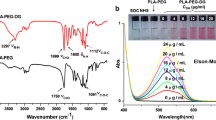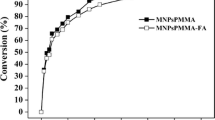Abstract
In this presented work, magnetic poly(HEMA-GMA) nanoparticles were synthesized, characterized, and used for immobilization of an anti-leukemic enzyme L-asparaginase. The average particle size of the synthesized magnetic nanoparticles was found to be as 117.5 nm. L-asparaginase was successfully immobilized onto the synthesized magnetic nanoparticles, and attached amount of L-asparaginase was found to be as 66.43 mg/g nanoparticle. The effects of the medium pH, temperature, and substrate concentration on the L-asparaginase activity were also tested. Optimum pH of the free and immobilized L-asparaginase was found to be as 7.5 and 6.5, respectively. Optimum temperature of the free L-asparaginase was 45 °C, while optimum temperature was shifted to 55 °C after immobilization onto the magnetic nanoparticles. Also, kcat value of free L-asparaginase (47,356 min−1) was calculated to be higher than that of immobilized L-asparaginase (497 min−1). Thermal stability of both asparaginase preparation was followed for 10 h, and at the end of the incubation time, free asparaginase almost lost its activity, while immobilized asparaginase protected 50% of its initial activity. Storage stabilities of free and immobilized asparaginase were also tested, and at the end of the 40 days storage, free asparaginase lost all of its activity, while immobilized asparaginase still showed 30% activity. Operational stability of immobilized asparaginase was tested for 8 successive usage, and immobilized asparaginase lost only 15% of its initial activity. In present study, activities of free and immobilized L-asparaginase were tested in artificial human serum medium, to foresee the in vivo efficiency, and it was demonstrated here that immobilized L-asparaginase protected its 74.74% of its initial activity in artificial serum medium.







Similar content being viewed by others
References
Narta, U. K., Kanwar, S. S., & Azmi, W. (2007). Pharmacological and clinical evaluation of L-asparaginase in the treatment of leukemia. Critical Reviews in Oncology/Hematology, 61(3), 208–221.
Verma, N., Kumar, K., Kaur, G., & Anand, S. (2007). L-asparaginase: a promising chemotherapeutic agent. Critical Reviews in Biotechnology, 27(1), 45–62.
Earl, M. (2009). Incidence and management of asparaginase-associated adverse events in patients with acute lymphoblastic leukemia. Clinical Advances in Hematology & Oncology: H&O, 7(9), 600–606.
Agrawal, N. R., Bukowski, R. M., Rybicki, L. A., Kurtzberg, J., Cohen, L. J., & Hussein, M. A. (2003). A phase I–II trial of polyethylene glycol-conjugated L-asparaginase in patients with multiple myeloma. Cancer, 98(1), 94–99.
Poznansky, M. J., Shandling, M., Salkie, M. A., Elliott, J., & Lau, E. (1982). Advantages in the use of L-asparaginase-albumin polymer as an antitumor agent. Cancer Research, 42(3), 1020–1025.
Gombotz, W. R., Hoffman, A. S., Schmer, G., & Uenoyama, S. (1985). The immobilization of L-asparaginase on porous hollow fiber plasma filters. Journal of Controlled Release, 2, 375–383.
Jean-Francois, J., & Fortier, G. (1996). Immobilization of L-asparaginase into a biocompatible poly (ethylene glycol)-albumin hydrogel: I: preparation and in vitro characterization. Biotechnology and Applied Biochemistry, 23(3), 221–226.
Vına, I., Karsakevich, A., & Bekers, M. (2001). Stabilization of anti-leukemic enzyme L-asparaginase by immobilization on polysaccharide levan. Journal of Molecular Catalysis B: Enzymatic, 11(4–6), 551–558.
Balcao, V. M., Mateo, C., Fernández-Lafuente, R., Malcata, F. X., & Guisán, J. M. (2001). Structural and functional stabilization of L-asparaginase via multisubunit immobilization onto highly activated supports. Biotechnology Progress, 17(3), 537–542.
Zhang, Y. Q., Tao, M. L., Shen, W. D., Zhou, Y. Z., Ding, Y., Ma, Y., & Zhou, W. L. (2004). Immobilization of L-asparaginase on the microparticles of the natural silk sericin protein and its characters. Biomaterials, 25(17), 3751–3759.
Teodor, E., Litescu, S. C., Lazar, V., & Somoghi, R. (2009). Hydrogel-magnetic nanoparticles with immobilized L-asparaginase for biomedical applications. Journal of Materials Science: Materials in Medicine, 20(6), 1307–1314.
Qiao, J., Qi, L., Mu, X., & Chen, Y. (2011). Monolith and coating enzymatic microreactors of L-asparaginase: kinetics study by MCE–LIF for potential application in acute lymphoblastic leukemia (ALL) treatment. Analyst, 136(10), 2077–2083.
Ghosh, S., Chaganti, S. R., & Prakasham, R. S. (2012). Polyaniline nanofiber as a novel immobilization matrix for the anti-leukemia enzyme L-asparaginase. Journal of Molecular Catalysis B: Enzymatic, 74(1–2), 132–137.
Sundaramoorthi, C., Rajakumari, R., Dharamsi, A. B. H. A. Y., & Vengadeshprabhu, K. (2012). Production and immobilization of L-asparaginase from marine source. International Journal of Pharmacy and Pharmaceutical Sciences, 4, 229–232.
Mu, X., Qiao, J., Qi, L., Dong, P., & Ma, H. (2014). Poly (2-vinyl-4, 4-dimethylazlactone)-functionalized magnetic nanoparticles as carriers for enzyme immobilization and its application. ACS Applied Materials & Interfaces, 6(23), 21346–21354.
Bahreini, E., Aghaiypour, K., Abbasalipourkabir, R., Mokarram, A. R., Goodarzi, M. T., & Saidijam, M. (2014). Preparation and nanoencapsulation of L-asparaginase II in chitosan-tripolyphosphate nanoparticles and in vitro release study. Nanoscale Research Letters, 9(1), 340.
Ulu, A., Koytepe, S., & Ates, B. (2016). Design of starch functionalized biodegradable P (MAA-co-MMA) as carrier matrix for l-asparaginase immobilization. Carbohydrate Polymers, 153, 559–572.
Ulu, A., Koytepe, S., & Ates, B. (2016). Synthesis and characterization of biodegradable pHEMA-starch composites for immobilization of L-asparaginase. Polymer Bulletin, 73(7), 1891–1907.
Bahraman, F., & Alemzadeh, I. (2017). Optimization of l-asparaginase immobilization onto calcium alginate beads. Chemical Engineering Communications, 204(2), 216–220.
Uygun, M., Jurado-Sánchez, B., Uygun, D. A., Singh, V. V., Zhang, L., & Wang, J. (2017). Ultrasound-propelled nanowire motors enhance asparaginase enzymatic activity against cancer cells. Nanoscale, 9(46), 18423–18429.
Monajati, M., Borandeh, S., Hesami, A., Mansouri, D., & Tamaddon, A. M. (2018). Immobilization of L-asparaginase on aspartic acid functionalized graphene oxide nanosheet: enzyme kinetics and stability studies. Chemical Engineering Journal, 354, 1153–1163.
Agrawal, S., Sharma, I., Prajapati, B. P., Suryawanshi, R. K., & Kango, N. (2018). Catalytic characteristics and application of l-asparaginase immobilized on aluminum oxide pellets. International Journal of Biological Macromolecules, 114, 504–511.
Ulu, A., Noma, S. A. A., Koytepe, S., & Ates, B. (2019). Chloro-modified magnetic Fe 3 O 4@ MCM-41 core–shell nanoparticles for L-asparaginase immobilization with improved catalytic activity, reusability, and storage stability. Applied Biochemistry and Biotechnology, 187(3), 938–956.
Ahmad, R., & Sardar, M. (2015). Enzyme immobilization: an overview on nanoparticles as immobilization matrix. Biochemistry and Analytical Biochemistry, 4(2), 1.
Vaghari, H., Jafarizadeh-Malmiri, H., Mohammadlou, M., Berenjian, A., Anarjan, N., Jafari, N., & Nasiri, S. (2016). Application of magnetic nanoparticles in smart enzyme immobilization. Biotechnology Letters, 38(2), 223–233.
Orhan, H., Evli, S., Dabanca, M. B., Başbülbül, G., Uygun, M., & Uygun, D. A. (2019). Bacteria killer enzyme attached magnetic nanoparticles. Materials Science and Engineering: C, 94, 558–564.
Alpay, P., & Uygun, D. A. (2015). Usage of immobilized papain for enzymatic hydrolysis of proteins. Journal of Molecular Catalysis B: Enzymatic, 111, 56–63.
Mashburn, L. T., & Wriston Jr., J. C. (1963). Tumor inhibitory effect of L-asparaginase. Biochemical and Biophysical Research Communications, 12(1), 50–55.
Zhang, Y. Q., Zhou, W. L., Shen, W. D., Chen, Y. H., Zha, X. M., Shirai, K., & Kiguchi, K. (2005). Synthesis, characterization and immunogenicity of silk fibroin-L-asparaginase bioconjugates. Journal of Biotechnology, 120(3), 315–326.
Youssef, M. M., & Al-Omair, M. A. (2008). Cloning, purification, characterization and immobilization of L-asparaginase II from E. coli W3110. Asian J. Biochem, 3(6), 337–350.
Funding
This study was funded by Adnan Menderes University Research Fund (grant number FEF-17001).
Author information
Authors and Affiliations
Corresponding author
Ethics declarations
Conflict of Interest
The authors declare that they have no conflict of interest.
Additional information
Publisher’s Note
Springer Nature remains neutral with regard to jurisdictional claims in published maps and institutional affiliations.
Rights and permissions
About this article
Cite this article
Orhan, H., Aktaş Uygun, D. Immobilization of L-Asparaginase on Magnetic Nanoparticles for Cancer Treatment. Appl Biochem Biotechnol 191, 1432–1443 (2020). https://doi.org/10.1007/s12010-020-03276-z
Received:
Accepted:
Published:
Issue Date:
DOI: https://doi.org/10.1007/s12010-020-03276-z




